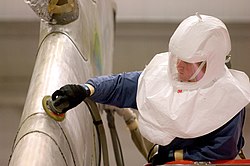This article needs additional citations for verification .(September 2008) |

A sander is a power tool used to smooth surfaces by abrasion with sandpaper. Sanders have a means to attach the sandpaper and a mechanism to move it rapidly contained within a housing with means to handhold it or fix it to a workbench. Woodworking sanders are usually powered electrically, and those used in auto-body repair work are usually powered by compressed air. There are many different types of sanders for different purposes. Multipurpose power tools and electric drills may have sander attachments.






